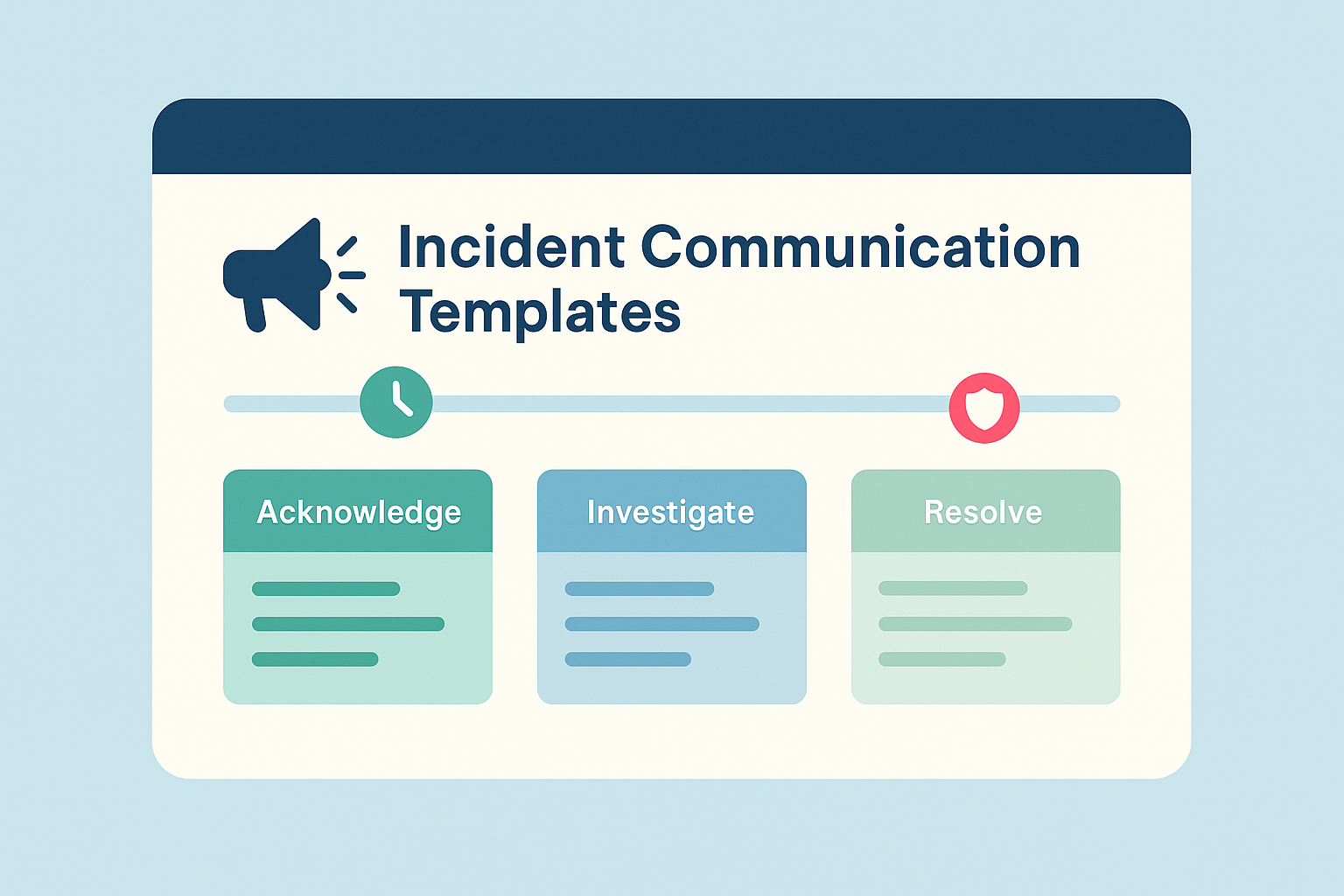Clear incident communication keeps customers calm, reduces duplicate tickets, and protects trust when things go wrong. With a simple policy and a few reusable snippets, small teams can publish timely updates without meetings or guesswork.
Why incident communication matters for small teams
Incidents can overwhelm lean teams if messages are slow or inconsistent. Customers need quick acknowledgment, a credible next update time, and a plain status. When you standardize the flow, agents respond faster and leaders get fewer escalations.
- Set expectations early with an acknowledgment and the next update time.
- Keep one source of truth to avoid conflicting messages.
- Close the loop with a clear resolution and any follow up action.
Business outcomes to target
- Fewer repeat emails during active incidents
- Shorter time to acknowledge and time between updates
- Higher satisfaction on incident related tickets
Incident communication policy in 20 minutes
Write a short policy that anyone can follow. Keep it to one page so people actually use it.
- Roles: who writes, who approves, and who presses publish.
- Channels: helpdesk reply, status page or pinned note, and optional in app banner.
- Cadence by severity: map Sev 1 to frequent updates, Sev 2 to scheduled updates, Sev 3 to next business day.
- Source of truth: link every message back to one canonical update.
- Runbook hook: point to a quick checklist for triage and escalation.
For routing and ownership, pair your policy with simple triage rules so incident emails reach the right person fast: small team triage rules.
A predictable cadence and a single source of truth prevent confusion.
Templates you can copy
These short snippets work across helpdesk replies, a status note, or a pinned update. Personalize names and times, then save them as canned responses.
Acknowledgment template
Subject: We are investigating now
Body:
Thanks for reporting this. We are investigating an incident that affects a portion of customers. Our next update will be at {local time + 30 min}. If you are blocked, reply with any error messages and we will prioritize your case.
Investigation update template
Subject: Update on the incident
Body:
We have identified the likely cause and are working on a fix. Current impact: {scope and symptoms}. Workaround: {steps if any}. Next update by {time} or sooner if status changes.
Resolution template
Subject: Resolved
Body:
The incident is resolved. Cause: {brief cause}. Fix: {what changed}. We will monitor for stability and share a short follow up summary within {timeframe}. If you still see issues, reply here and we will help.
Optional postmortem snippet
Subject: Follow up summary
Body:
Here is a short summary of the incident: {impact}, {timeline}, {root cause}, and {prevention}. Thank you for your patience.
Tone, clarity, and ownership
Use a consistent tone that accepts responsibility and sets clear expectations. Avoid jargon unless it helps customers act. Close every message with the next update time so people know what to expect.
- Lead with the customer impact, not the internal error code.
- State who owns the next step and when the next update will arrive.
- Offer a workaround when possible.
- Include a single link to the canonical update to keep messages aligned.
For thoughtful language on apologies and accountability, review how to apologize well in business contexts: The Organizational Apology.
Make it consistent inside your helpdesk
Turn the snippets into saved replies and quick insert macros so every agent stays on message.
- Create canned responses for acknowledge, investigation, and resolved.
- Pin the latest status as a note that agents can reference in replies.
- Add a tag such as
incidentto group related tickets for easy reporting.
If you need ready made wording for everyday replies, grab these saved replies as a starting point and adapt them for incidents: 15 templates for small teams.
Cadence and channels by severity
Tie update frequency to severity so your team knows when to publish.
Severity map
- Sev 1: page immediately, acknowledge within 10 minutes, update every 30 minutes until resolved.
- Sev 2: acknowledge within business hours, update every 90 minutes while working, daily summary if prolonged.
- Sev 3: confirm receipt and share the next business day update; collect details for debugging.
Channels to use
- Helpdesk reply: personal and trackable, ideal for the customer who wrote in.
- Status note or pinned article: the single source of truth for everyone.
- In app banner: optional, for widespread impact or login issues.
Measure and iterate
Keep metrics light, then refine the policy during a short weekly review.
- Time to acknowledge: minutes from ticket creation to first response.
- Update cadence adherence: how often you met the promised update times.
- Sentiment on incident tickets: quick rating or short survey after resolution.
For a deeper view on measurements that matter, use this primer on helpdesk metrics designed for small teams: helpdesk metrics to track.
Budget and planning note
Incidents carry a real cost. Plan for a lightweight toolset, training time, and occasional comp time for people who work nights or weekends. If you need to compare plans, see our transparent pricing for small teams.
Conclusion
Good incident communication turns chaos into clarity. With a short policy, a severity based cadence, and a few reusable templates, your team can publish fast, confident updates and keep customers informed from start to finish.
Start your free 14-day trial, no credit card required.
